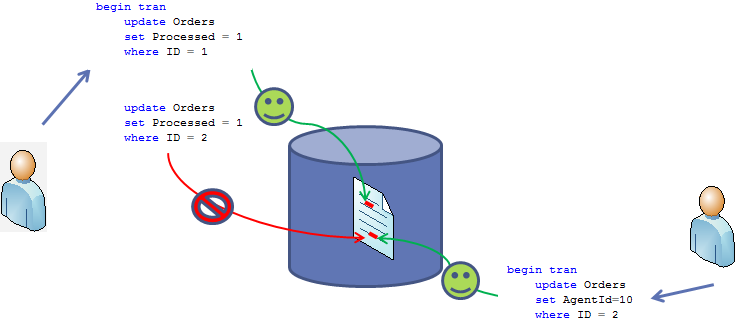We already know why blocking occurs in the system and how to detect and troubleshoot the blocking issues. Today I’d like us to focus on the deadlocks.First, what is the deadlock? Classic deadlock occurs when 2 processes compete for the resources and waiting on each other. Let’s take a look on that. Click on each picture below to open them in the different window. Let’s assume that Orders table has the clustered index on ID column.Let we have the session 1 that starts transaction and updates the row from the Order table. We already know that Session 1 acquires X lock on this row (ID=1) and hold it till end of transaction
Now let’s start session 2 and have it update another row in the Orders table. Same situation – session acquires and holds X lock on the row with (ID = 2).
Now if session 1 tries to acquire X lock on the row with ID = 2 , it cannot do that because Session 2 already held X lock there. So, Session 1 is going to be blocked till Session 2 rollback or commit the transaction
It worth to mention that it would happen in any transaction isolation level except SNAPSHOT that handles such conditions differently. So read uncommitted does not help with the deadlocks at all.
Simple enough. Unfortunately it rarely happens in the real life. Let’s see it in the small example using the same dbo.Data table like before. Let’s start 2 sessions and update 2 separate rows in the table (acquire X locks).Session 1:

Session 2:

Now let’s run 2 selects.Session 1:

Session 2:

Well, as you can see, it introduces deadlock.

To understand why it happens, let’s take a look at the execution plan of the select statement:

As you can see – there is the table scan. So let’s think what happened
- First of all, we have 2 X locks on the different rows acquired by both sessions.
- When session 1 ran select, it introduced table scan. In read committed, repeatable read or serializable isolation levels, readers issue shared S locks, so when session 1 tried to read the row with ID = 40000 (X lock held by session 2) – it was blocked.
- Same thing happens with session 2 – it’s blocked on the row with ID = 1 (X lock held by session 1).
So this is the classic deadlock even if there are no data updates involved. It worth to mention that read uncommitted transaction isolation level would not introduce deadlock – readers in this isolation level do not acquire S locks. Although you’ll have deadlock in the case if you change select to update even in read uncommitted level. Otimistic isolation levels also behave differently and we will talk about it later.So as you can see, in the real life as other blocking issues deadlocks happen due non-optimized queries.
Next week we will talk how to detect and deal with deadlocks. Source code is available for download



